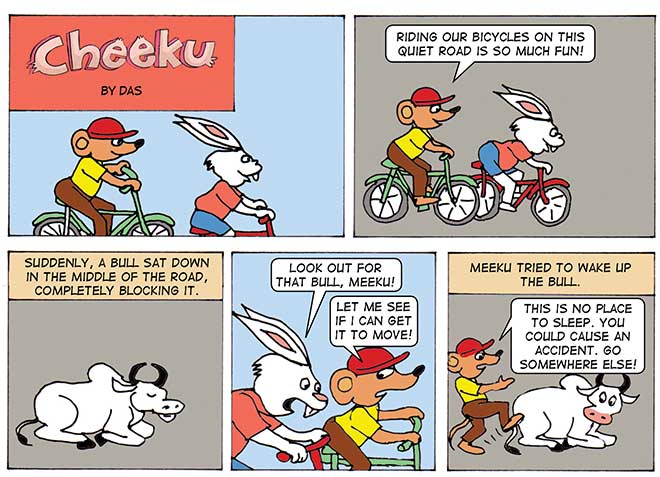
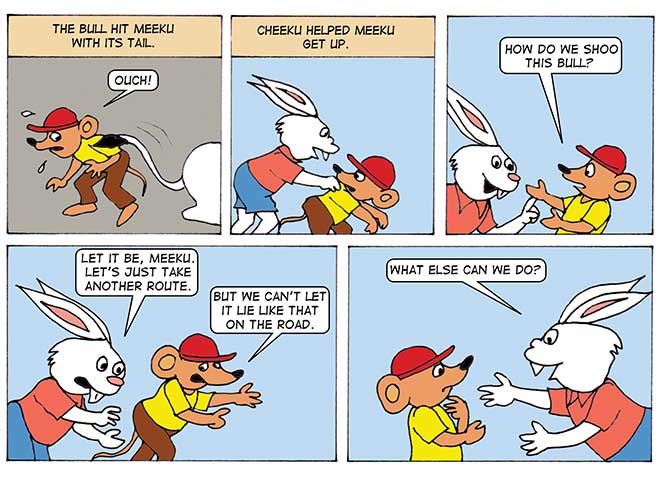
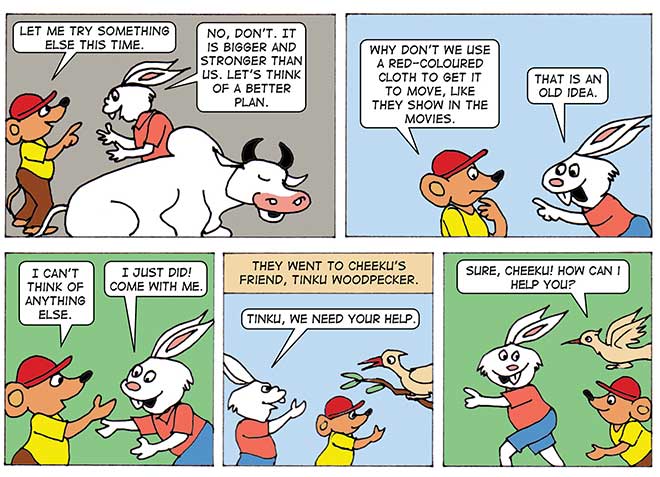
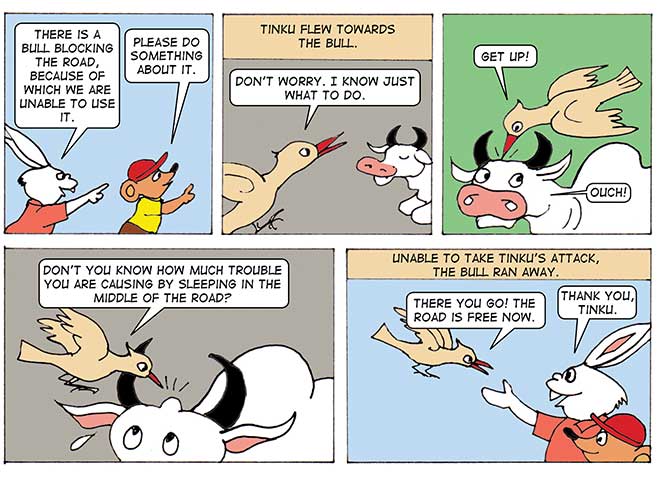
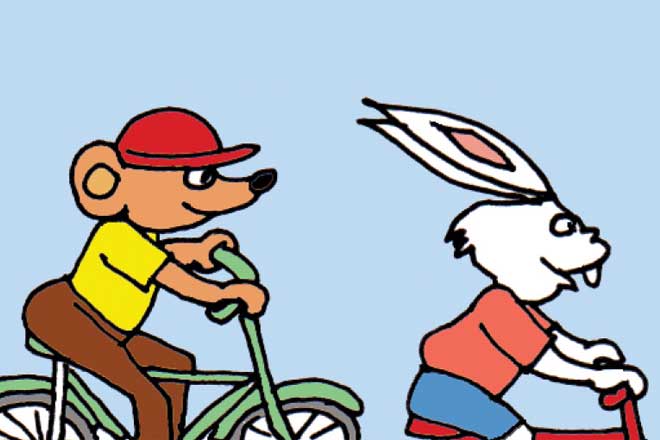
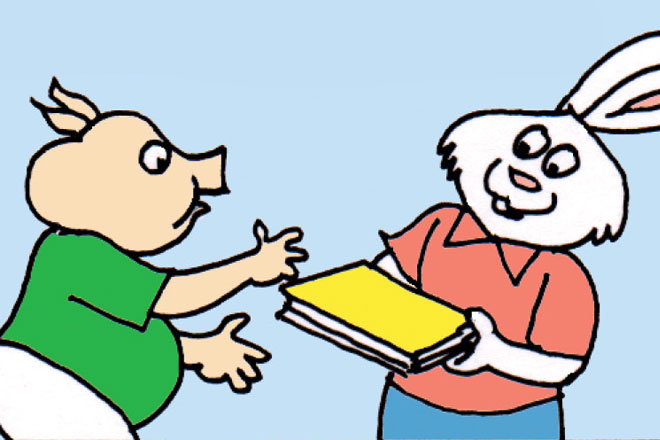

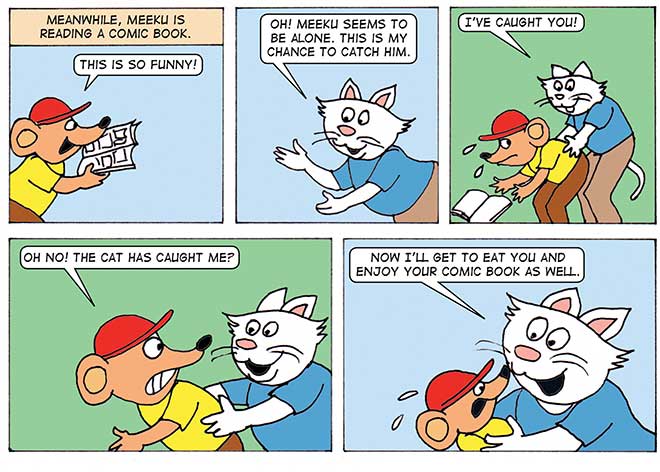
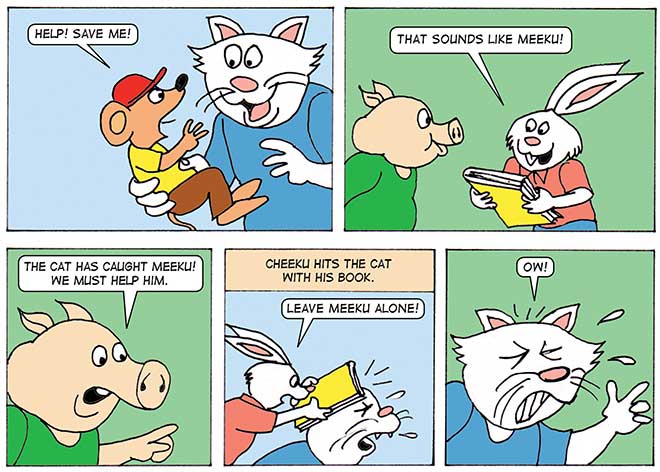
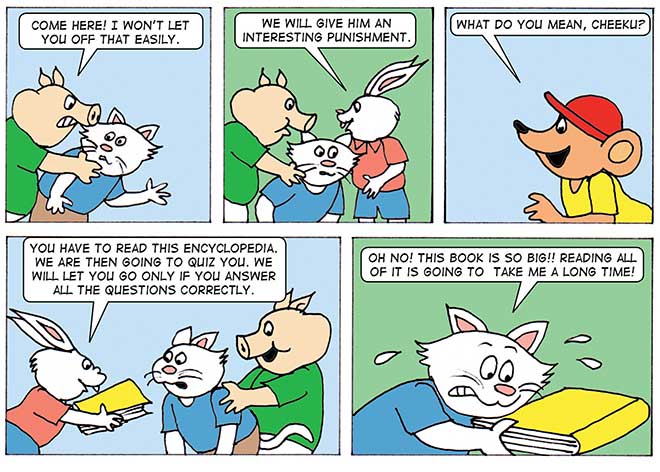
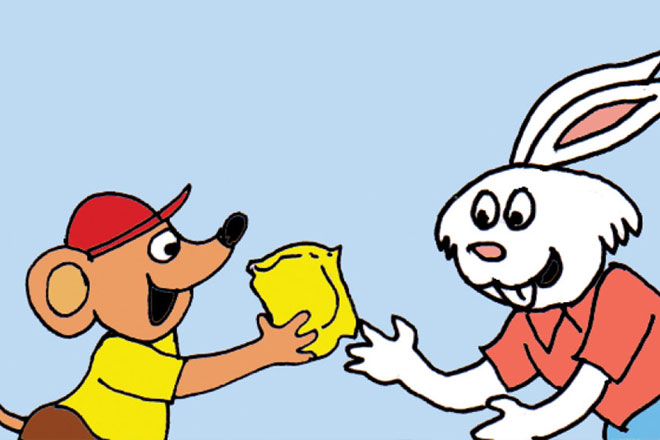
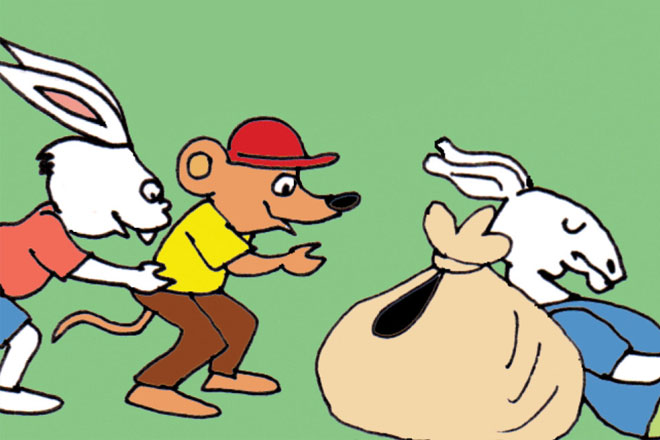
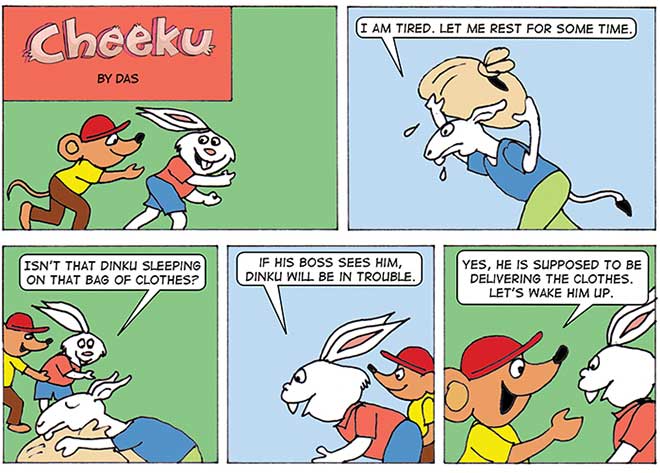
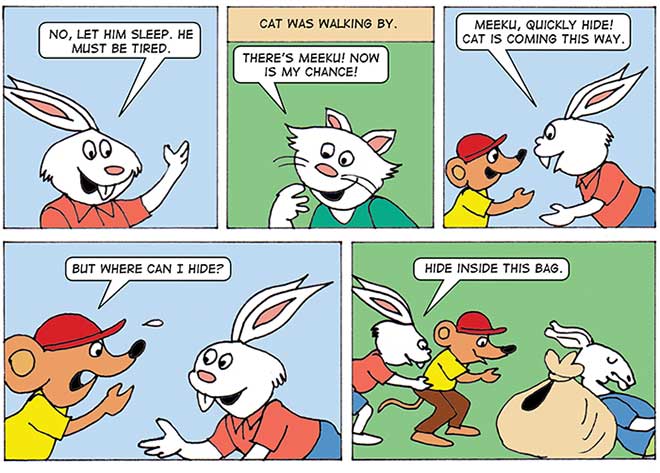
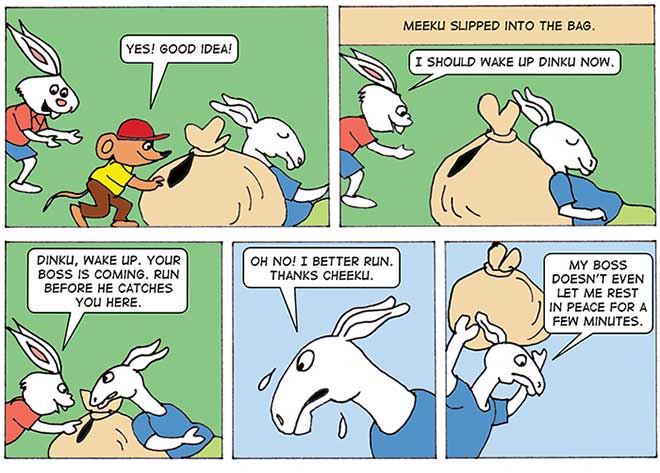
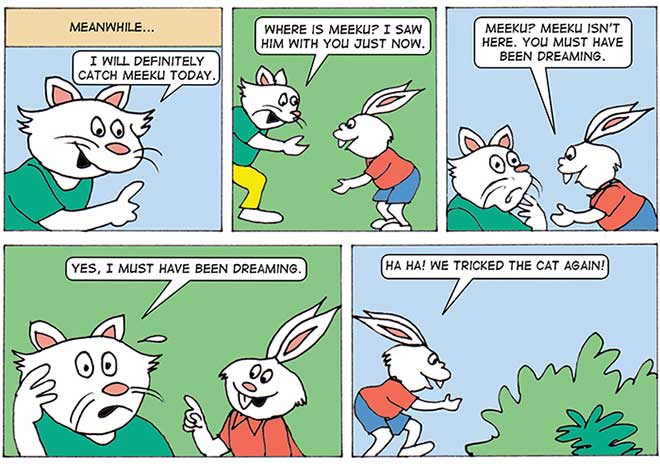
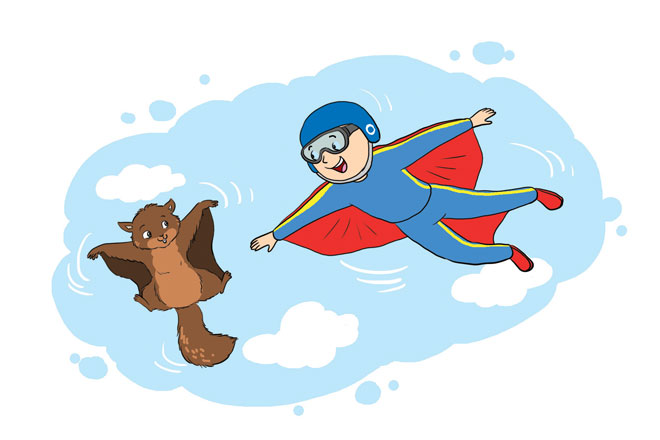
Ever seen a bird or an aeroplane and immediately thought of flying? Though we do not have wings, we do keep trying to fly. This would explain the popularity of sports like skydiving and paragliding. But there is one animal that does not need wings to fly: the flying squirrel.
The flying squirrel, found in North America, does not exactly fly; it glides from one tree to another.
The flying squirrel has extra skin that stretches from its front legs to the hind legs on both sides. When it wants to move from one tree to another, it launches itself from a high branch and spreads out its body as it jumps.
The extra skin stretches, looking and working like a parachute, helping it glide and land on a lower branch of the other tree. It can even change direction by moving its limbs accordingly. The flying squirrel’s tail acts like a brake which curves just before landing and slows it down. The tail also acts like a rudder, helping it change direction mid-air.
Box: A flying squirrel can cover a distance of 150 feet in a single glide.
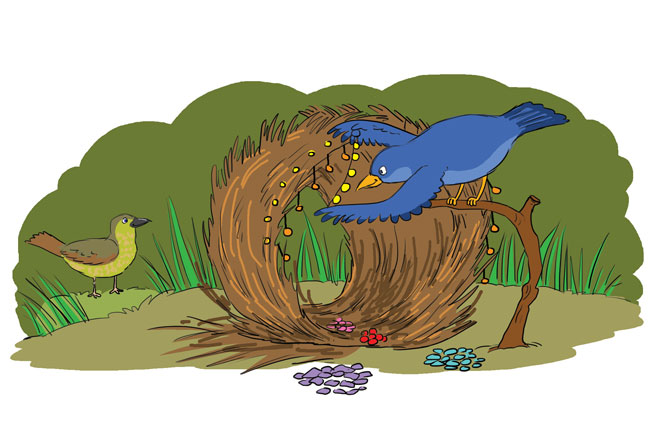
Some people love decorating their house. There are also people who specialise in it called interior decorators. In the animal kingdom too, there is a species of bird that is known for its masterful building and decorating skill.
The bowerbirds are native to Australia and New Guinea. They are known for their unique courtship behaviour. Unlike the peacocks that use their colourful plumage to attract the females, the bowerbirds have to use their talent of building elaborate structures called bowers.
They build two types of structures—one is a tent-like structure supported by a sapling and the other resembles an archway.
The bowerbirds also decorate their bowers with objects they can find in the surroundings, grouping them according to colour. They use objects like flowers, shells, beetles, leaves, and even pens, toys, and paper or bottle caps—as long as they fit their choice of colour.
Box: The female of the species, which usually raises its little ones as a single mother, visits several bowers at a time inspecting the quality of each structure before finally choosing its mate.
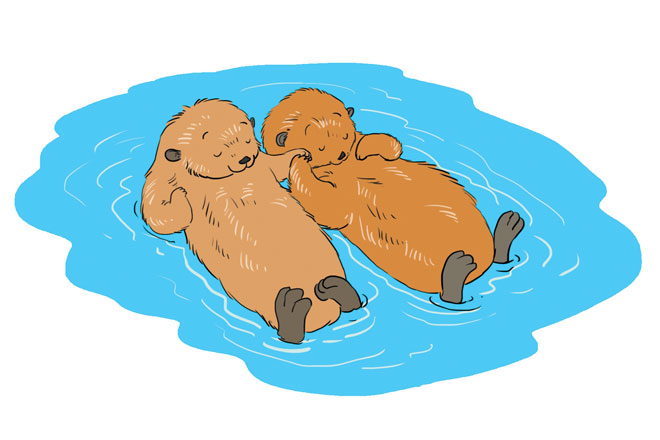
When we go out for a walk with our parents or siblings, we hold their hands. We do this so that we don’t get lost in the crowd and it makes us feel safe. Did you know that sea otters also do the same?
Sea otters are found along the coasts of the Pacific Ocean in North America and Asia. They spend most of their time in water, floating on their backs and even sleeping that way.
When they sleep, they hold their partner’s paws so that they do not drift away from each other because of the ocean currents. When a group of sea otters hold paws and float together, it is called a “raft”. The largest “raft” ever seen consisted of over 2000 sea otters floating together.
Female sea otters hold their young ones on their chest while floating on their backs.
Sometimes, it entangles itself and its baby in giant seaweed or other sea plants so that it does not drift off.
Box: Sea otters, like humans, often hunt and eat together with their partners or in a group.
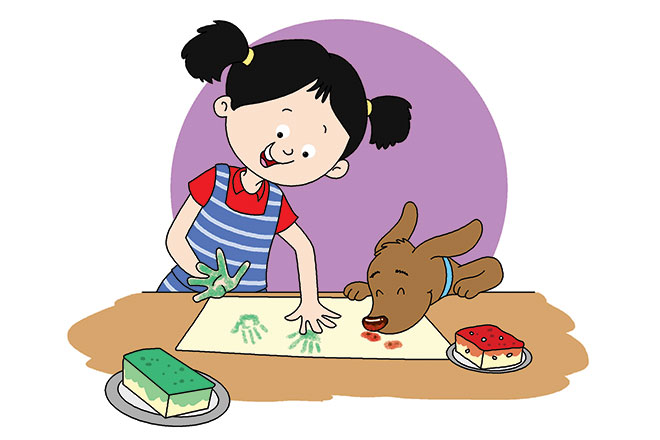
Humans look different from each other and even have different personalities. We also have something else that is unique to each individual and is used for identification purposes—our fingerprints. Similarly, animals also have unique prints that are used to differentiate one individual from the other.
If you look at a dog’s nose closely, you will notice that it is thick and textured. Made up of three layers of skin, the outermost layer has grooves which give it its textured appearance. This texture is unique to each dog, just like our fingerprints. Hence, a dog can be identified by its nose print.
Animals like tigers and zebras, on the other hand, are identified by the unique pattern of their stripes. No two tigers or zebras have the same pattern of stripes.
Such identification methods help biologists and conservationists to count and keep track of an animal’s age, health, family and movement in the wild.
Box: Whale sharks have dots on their skin that look like stars. These are unique to every whale shark. Biologists identify them by studying these patterns on the body of the whale shark.
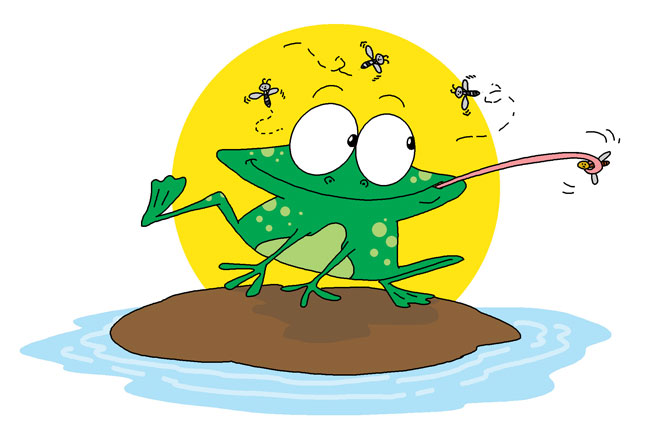
After it rains, we can hear the croaking of frogs all around. Frogs love the damp environment during rains and hence are commonly seen during the monsoon. They also hop out into the open looking for dinner. And just like how we stretch our hands to reach for something, a frog stretches its tongue to grab its prey.
A frog usually feeds on flies, moths and grasshoppers. The larger ones even feed on mice. A frog’s tongue generally remains coiled inside its mouth surrounded by soft muscles. When the frog spots a prey, the muscles quickly harden to shoot out the tongue with great speed. The sticky saliva on the tongue helps it grab the prey, after which the tongue immediately snaps back into its mouth. The entire process takes place in less than a second.
A frog’s tongue is attached to the front of its mouth and not connected to the throat unlike humans which adds to its speed. The force with which a frog shoots out its tongue is so great that it can even catch prey that is bigger than itself. A frog has tiny teeth that it uses only to keep its prey inside its mouth. It does not use them to chew its food.
Box: Some frogs don’t even have a tongue; they directly grab their prey with their mouth.
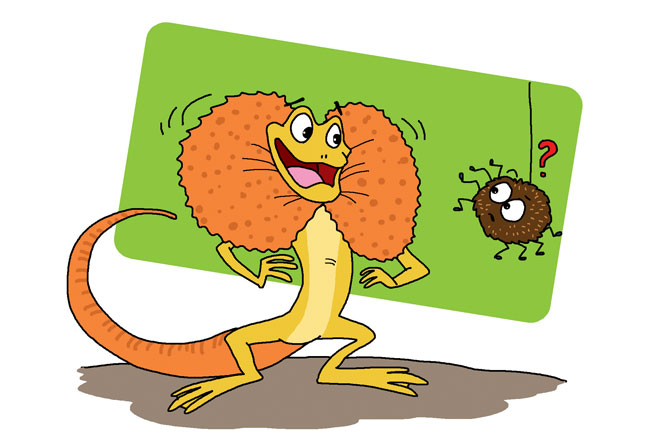
You have seen frills on dresses. But did you know that particular lizards have frills on their neck?
The frilled lizard is commonly found in Australia and spends most of its time on trees, and it comes down only when it needs food. The frill that this lizard sports is a layer of skin that remains folded on its neck.
The neck frill is supported by lines of strong muscles that are connected to its jaw bone. This loose skin is usually a bright colour like red or orange. It expands when the lizard hunts or goes into defence mode.
When the lizard feels threatened, it stands on its hind legs, opens its mouth, unfurls its skin frill and hisses at its predator. However, if it knows that the predator is not intimidated by this show, it just takes an about-turn and sprints to safety. This behaviour of threatening a predator to scare it off is known as deimatic behaviour.
Box: The frilled lizard is also known as the frilled dragon.
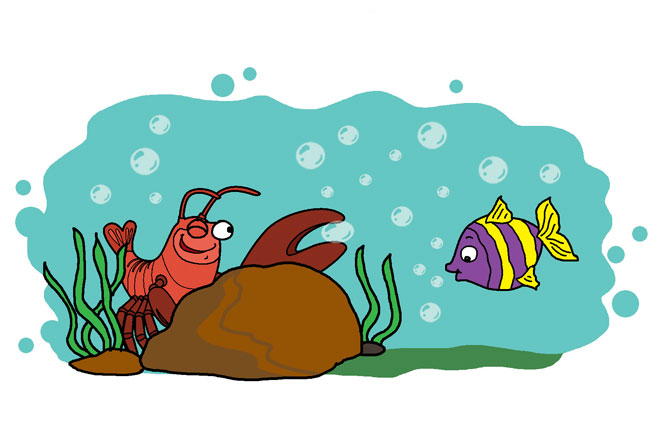
What if your right arm was twice as long as the left arm? Then you could learn to use it your advantage like the snapping shrimp!
The snapping shrimp is known for its disproportionate claws where one is bigger than half its body. The bigger claw cannot be used to attack because it is not shaped like a pincer that most shrimps have. Instead, it looks more like a pistol and hence this shrimp is also known as pistol shrimp. With this claw, the shrimp creates a loud sound, which has the effect to stun its prey. The shrimp snaps its claw shut so fast that a jet of water shoots out and a bubble is formed inside. When it opens its claw, out comes the bubble which pops with a loud bang, thereby stunning its prey.
When it is hunting, the shrimp lies low in an obscure spot and waits for a fish to pass by. When it spots one, it steps out of its hiding place and “shoots” at its prey. When the fish is stunned by the sound, the shrimp pulls it into its hiding place and feeds on it.
Box: The bubble released by a snapping shrimp can also cause a flash of light. This phenomenon is called sonoluminescence.
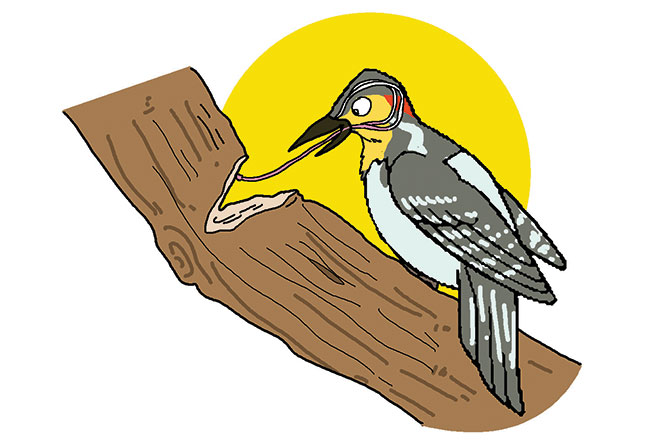
We stick out our tongues to see how much it can stretch to lick an ice cream in front of us. Woodpeckers do the same when trying to catch insects. Just that some woodpeckers have tongues that are as long as their bodies!
The average human tongue is 3.9 inches long, which is a fraction of the length of our body. The Grey-Faced woodpecker has a tongue that is almost 7 inches long which is about 2.8 times the length of its beak and longer than its entire body. This species of woodpecker has a barbed tongue that acts like a spear to catch insects, when it sticks its tongue inside trees.
But where does it store its long tongue? The tongue splits into two and curls back into the back of its head, where it rejoins and inserts into its right nostril (as shown in the illustration). In spite of having a long tongue, the woodpecker does not have a vocal song. It makes a drumming sound on hollow trees or logs to communicate.
Box: A woodpecker has a layer of sticky saliva on its tongue to help it catch insects.
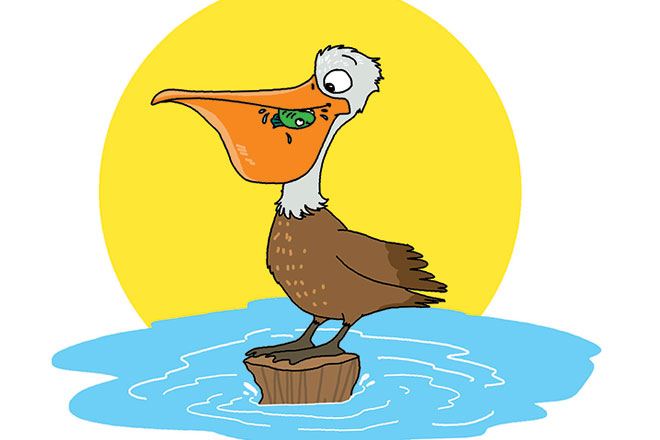
When we drink water, we take small and big sips from the bottle, definitely not more than half a glass at a time on an average. The pelican though can hold up to almost 11 bottles of water in its bill! That is almost three times the capacity of its stomach.
The pelican is the bird with the largest bill—it can be as long as 18 inches in length. The bottom half of its bill is basically just a frame holding loose skin called gular pouch that stretches to hold water. It especially comes in handy while it is “fishing”.
The pelican locates its prey—mostly fish—and then chases it to a shallow spot so that it can scoop it up along with the water and hold it in its bill. It then opens its bill a bit and contracts the pouch so that only water flows out and the fish remains inside it. This process is important as a pelican cannot eat or fly with its bill full of water. Finally, with a jerk of its head, it pushes the fish down its throat.
A pelican can even turn the pouch inside out by turning its neck!
Box: The pelican also uses its pouch also as a cooling device. When it is warm, it swings its pouch to cool itself.
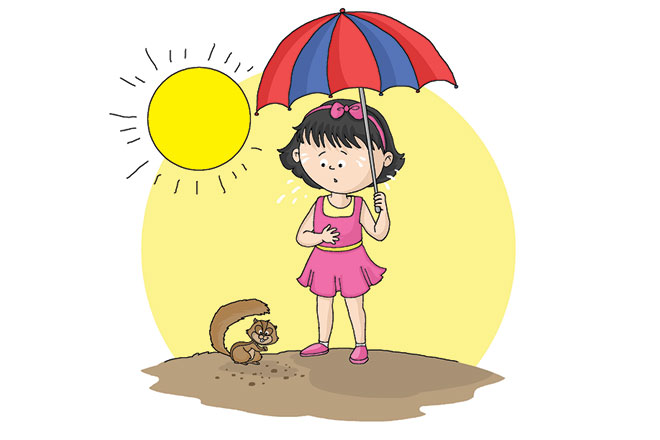
Summer is here. As the sun beats down on us, we need caps and umbrellas to shield us from the harsh sun. So, we carry them whenever we step out.
The cape ground squirrel of South Africa too carries its umbrella everywhere it goes. It cannot leave it behind even if it wants to. Do you know why? Because it uses its tail as an umbrella!
The cape ground squirrel lives in the Kalahari Desert in South Africa. It lives in burrows and not trees, unlike the other squirrels we see in our gardens and parks. This is because there are no trees in the desert.
The squirrel spends it day foraging for plants and seeds around it burrow. So, it cannot avoid going out in the sun. That’s when its bushy tail comes in handy. It uses its bushy tail to cover its head while it is searching for food. While foraging, the squirrel positions itself with its back facing the sun and its tail erect and above its head.
Box: The cape ground squirrel spends the hottest part of the day in its burrow, which are much cooler because that are about 60cms below the ground.
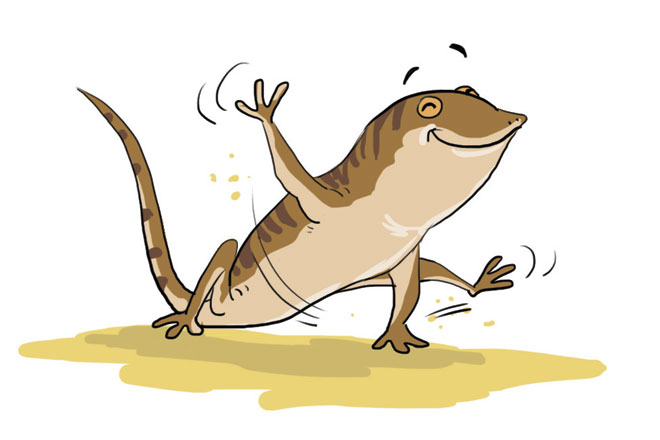
Summer is almost here. When the temperature goes up, we turn to cold drinks and ice creams to cool ourselves down. But the shovel-snouted lizard has an innovative way to cool off when the weather becomes too hot—it starts to dance!
The shovel-snouted lizard is found in the world’s third largest desert—Sahara, in Northern Africa. When the sand becomes too hot to stand on, the lizard balances itself on its tail and raises two of its feet at a time— alternating between front left and the rear right, and vice-versa—for about 10 seconds each. It does so to cool its feet. When the shovel-snouted lizard does this, it looks as if it is dancing.
The lizard also uses the sand to its advantage to hide and hunt. When the lizard spots a predator, it dives and buries itself in the sand. It stays hidden under a layer of sand and pops only its head out. It does the same while hunting too. The lizard surprises its prey by quickly emerging from under the sand and grabbing it. It usually feeds on small insects like beetles, moths and spiders.
Box:The shovel-snouted lizard can remain buried deep in the sand for an entire day.
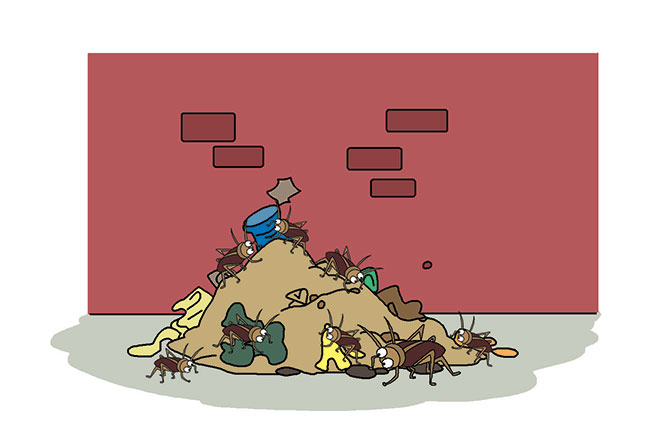
What purpose do pests like cockroaches serve?
Dear Jane,
There are 4, 000 varieties of cockroach of which only 10 are considered pests. They are omnivore scavengers that clean up our environment and help recycle the organic litter that would accumulate if it were not decomposed by organisms, including cockroaches. They serve to recycle human waste. If they did not exist, the pile up of human waste would be so large that we would die in the filth. They turn all the leaves and paper into soil. Furthermore, they serve as food for small mammals, birds, amphibians and lizards.

Are dogs sensitive to vaccinations?
Dear Abhinav,
Some dogs are allergic to vaccinations. The side-effects of vaccinations can vary with the type of vaccine used, and the age and breed of the animal vaccinated. Check with the veterinarian if there is a drug that can be given prior to the vaccination to prevent the allergic reactions. Once home, keep a close eye on your dog to see if there are any signs of pain, swelling, redness, and irritation at the injection site. These effects generally occur within 30 minutes to 1 week of the date of vaccination. If the signs persist, or are severe, contact your veterinarian. Never give more than one vaccine in a day. Give a gap of at least a couple of weeks between vaccinations.
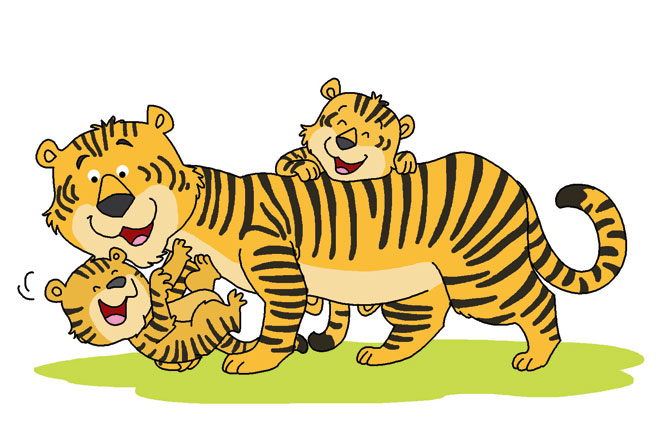
Is it true that tigers like to be on their own unlike the lions?
Dear Nimrat,
Yes. Except for a mother and her cubs, tigers live and hunt alone. Tigers have their own territories and interact only during the mating season to give birth. If tigers encounter each other at other times, they will try to defend their own territories. Scent marks and visual signs, such as scratch marks on trees, allow them to track other tigers in the area, and even identify individuals. A female tiger is also keenly aware of the other females whose territories are around her’s; in many cases, a tiger in the neighbouring territory may be her daughter. However, tigers do get together at times to hunt, especially when the prey is big like a water buffalo.
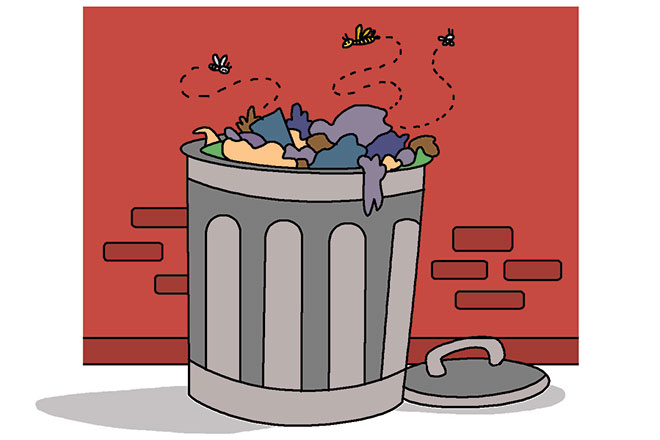
Garbage attracts crow and rats. Does it attract anything else too?
Dear Nilesh,
Uncovered food, sweets, cola cans and ice cream sticks attract wasps. Wasps require carbohydrates and so are attracted to food smells and that is why they can be commonly found around garbage. But wasps can spread diseases and so sanitation outside the house is extremely important. Garbage areas need to be meticulously clean. Keep the lids of garbage bins on and don’t put leftovers in open buckets. Spray the area with disinfectant regularly.
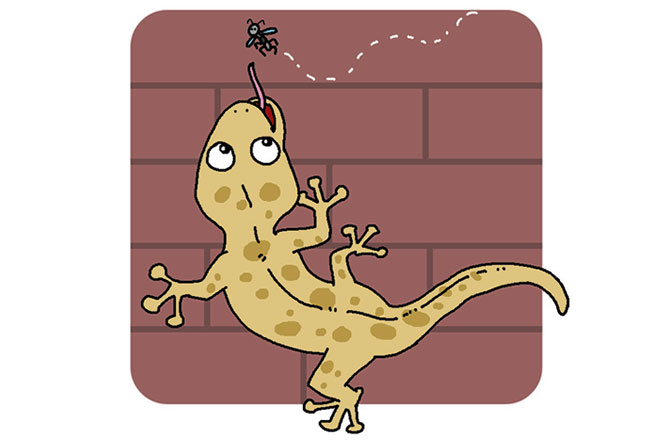
Is there anything I can do to discourage lizards from living in my house?
Dear Shailendra,
Lizards feed on the insects that are attracted to the lights in and around your house and thereby keeping them in check. One way you could reduce the insects in the house is by decreasing the lighting or shifting to yellow lights. Reduced lighting attracts fewer insects, and fewer insects mean fewer lizards.
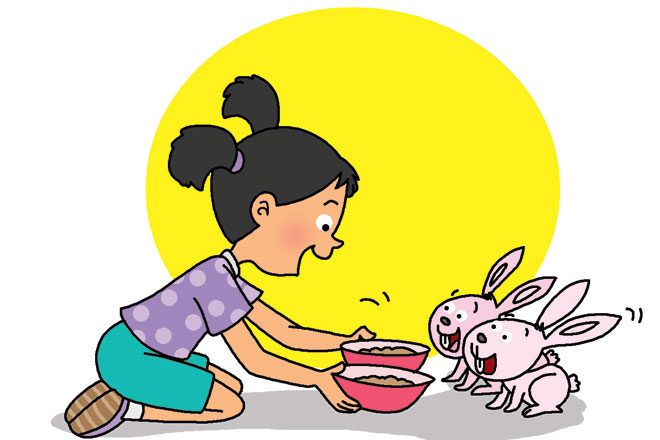
We have two rabbits at home. When we pet one rabbit, the other gets angry and scratches us with his paw. Please tell us how we can avoid this?
Dear Kartikey,
All animals are sensitive, especially rabbits. They also get angry easily. So, what you need to do is pet them both at the same time and make sure that you don’t play favourites. I hope they are both being fed at the same time in different bowls. If both the rabbits are male, they will be competitive.
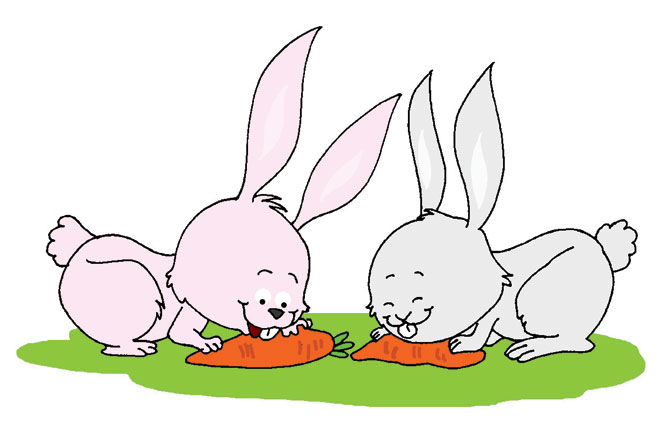
Why do rabbits thump their feet on the ground?
Dear Mohan,
For rabbits, thumping the back foot is a natural reaction to any danger that they may have sensed through smell, sound or sight. At such times, a rabbit will stand on all four feet, sometimes in a tip-toe position, with its ears perked up, and then thump its back foot to warn the other rabbits in the warren—a network of interconnecting rabbit burrows—that there is danger. Some rabbits will thump just one foot, or thump both at the same time. Rabbits aren’t very vocal animals, so thumping is an important way of communicating with each other. They may remain in the thumping position until they are convinced that the danger is gone.
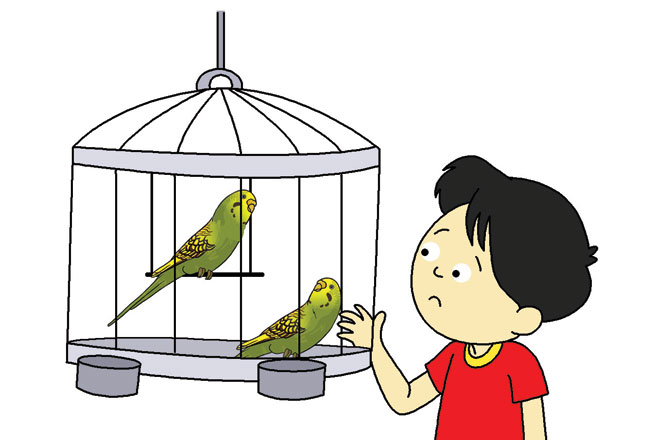
My pet bird constantly pecks itself and pulls out its feathers. It now has bare, red patches all over its body. What should I do?
Dear Pallavi,
Birds usually pluck their feathers to preen and groom themselves. Birds that are bored do it more frequently. For some birds, it is also a means of displaying anxiety. Anxiety can be caused due to various reasons: lack of fresh air or light, loud noises, changes in their environment or loneliness. But feather-plucking in particular could mean any of the following: stress, insufficient diet and internal or external parasites. In all of these, birds resort to plucking their feathers due to discomfort. Thus, to tackle this problem, try keeping your bird busy with toys or by changing its environment to reduce isolation. Talk to your vet about introducing omega fatty acids into your bird’s diet as it has been proven successful in reducing feather-plucking behaviour in birds.
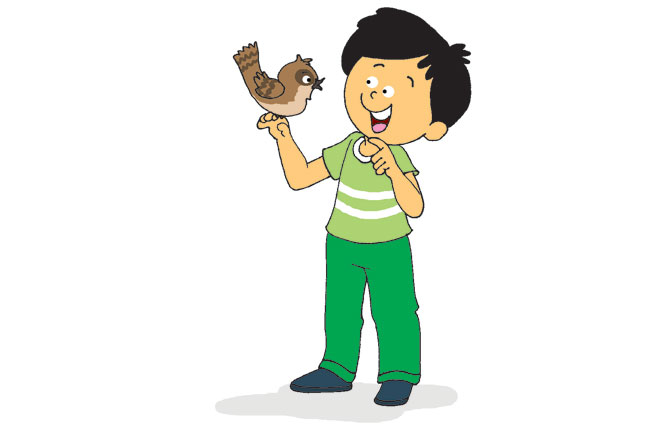
How do birds survive in cold weather?
Dear Sharmila,
Many birds like storks move to warmer areas before winter and stay there until winter is over. That way, they can stay warm and find food as well. Other birds stay together as a flock in the winter and eat fatty foods, like black-oil sunflower seeds, as much as possible. After they have eaten enough, they get puffy and rest. Feathers, in addition to protecting the birds from the cold air, also help trap body heat, thus keeping them warm.
Small birds look for small nooks to nestle in, while some others like the kinglets and chickadees lower their body temperature to save energy.
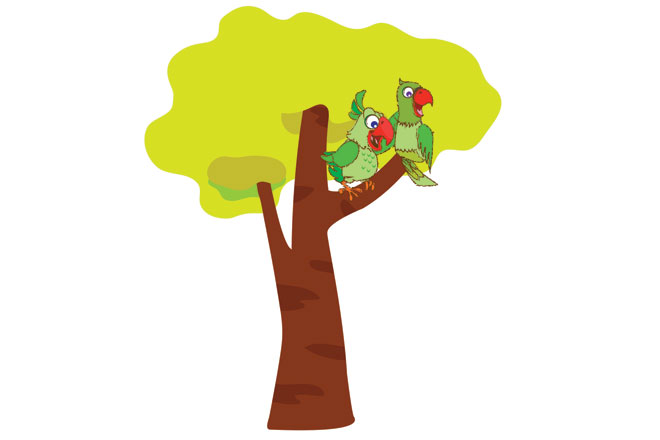
Why do parrots love eating chillies? Can they eat them all the time?
Dear Subarnarekha,
Chillies have a chemical called capsaicin which makes our tongue burn. As a result, we cannot eat too much of it. However, capsaicin has no effect on birds. Chillies contain nutrition and vitamins which are good for them. However, they are not the only food parrots should eat. They have to be given a variety of foods such as grains, fruits, vegetables and nuts.
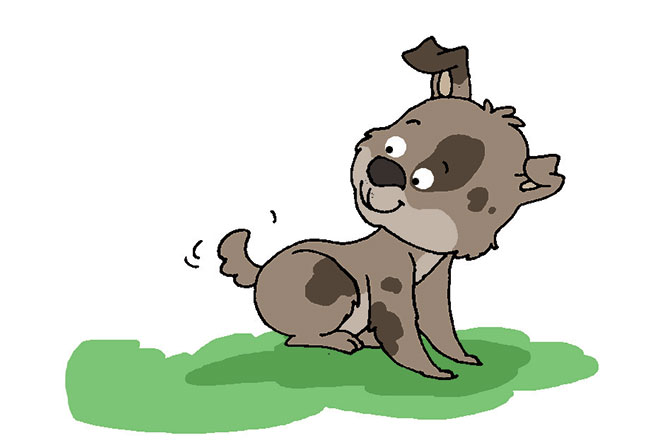
What can we do to save street dogs and cats from the harsh weather?
Dear Avisha,
Try planting as many trees as you can, as trees help protect animals from the harsh weather. Keep bowls of water out for them in summer. During winter, feeding the strays will help them survive the cold. You could also build a small enclosure for the animals outside your house using a cardboard box and leave some blankets inside for them.
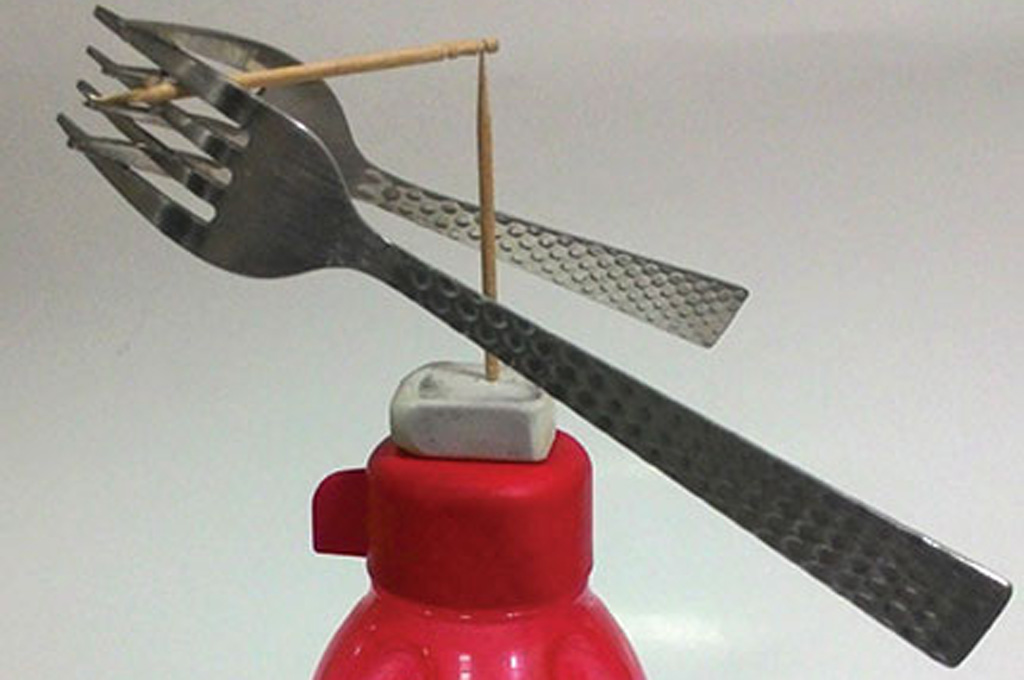
Stuff:
• Two forks,
• Two toothpicks,
• A bottle with water,
• Eraser
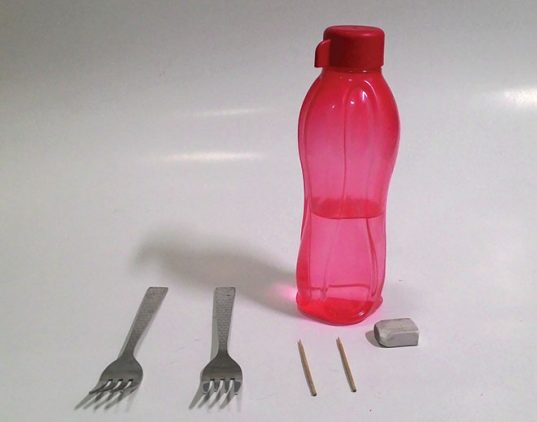
Do:
1. Fix a toothpick to the eraser by piercing it in the centre with the blunt end of the toothpick. Place eraser on top of the bottle.
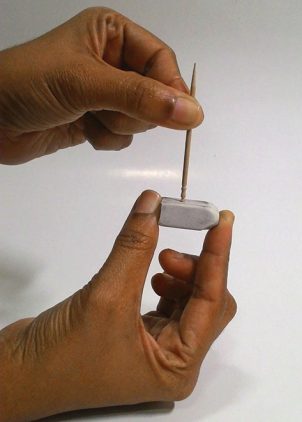
2. Take the two forks and interlock them tightly as shown.
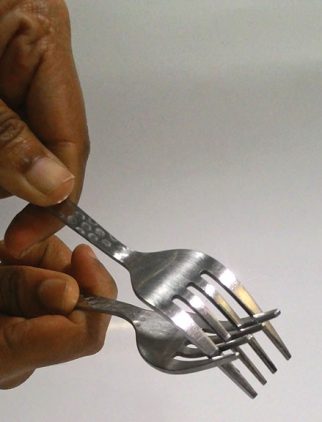
3. Insert the pointed end of the second toothpick through the interlocked forks
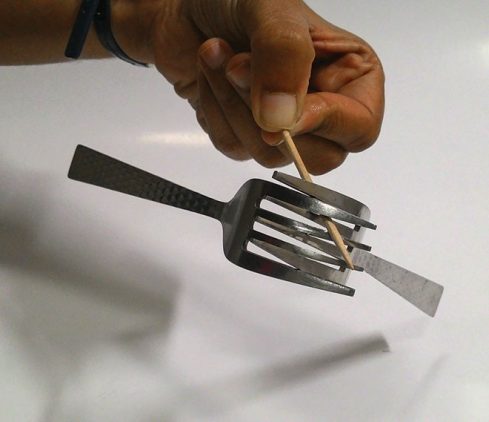
4. Carefully lift the forks using the toothpick and place its blunt end on top of the pointed end of the toothpick attached to the eraser.
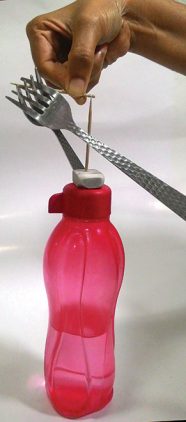
See: When you place the toothpick with the forks attached to it on top of the other toothpick, it does not fall! The entire construct balances on the tip of the second toothpick.
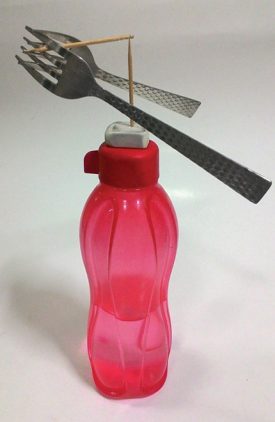
Think about:
Why didn’t the forks fall?
For an object to be balanced the weight must be equally distributed on both sides. In a scale, for example, you can easily balance it on your finger tip by identifying the half-way mark. If one side is longer than the other, the ruler will fall. This half-way mark is called the centre of gravity–the point in an object where the object’s mass is concentrated and can be used to balance it.
In this experiment, the centre of gravity for the two forks is on the point where it is interlocked because that is where the mass is concentrated. When the toothpick is inserted at that point, and placed on the second toothpick, the centre of gravity of the entire structure shifts to the toothpick, because of which it stays balanced without toppling.
Let’s find out:
How important is the centre of gravity in the design of a vehicle?
The concept of centre of gravity finds practical applications in the automobile industry. While designing a vehicle, the centre of gravity is kept in mind so as to ensure the safety and efficiency of a vehicle. In cars, the centre of balance is kept low to prevent them from toppling over on their sides when taking sharp turns. In an aircraft too, the centre of balance is carefully determined during the design stage. It is crucial for the aircraft’s stability and control.
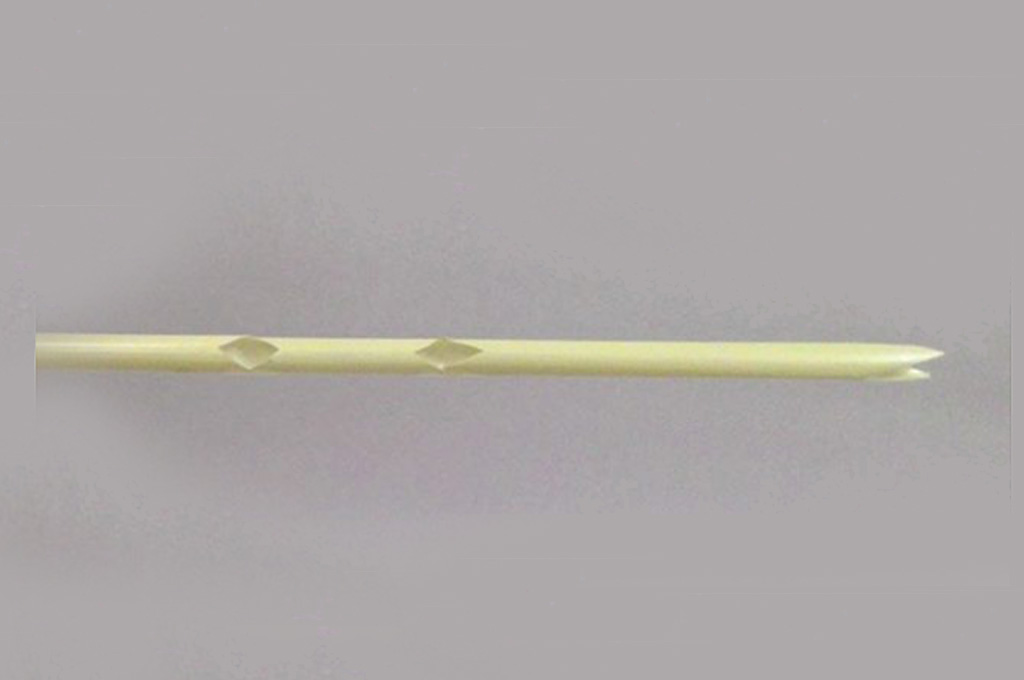
Stuff:
• A straw
• A pair of scissors
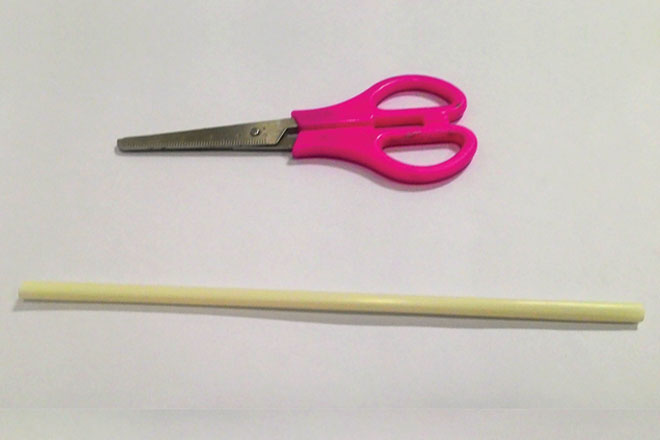
Do:
1. Flatten the tip of a straw at one end as shown.
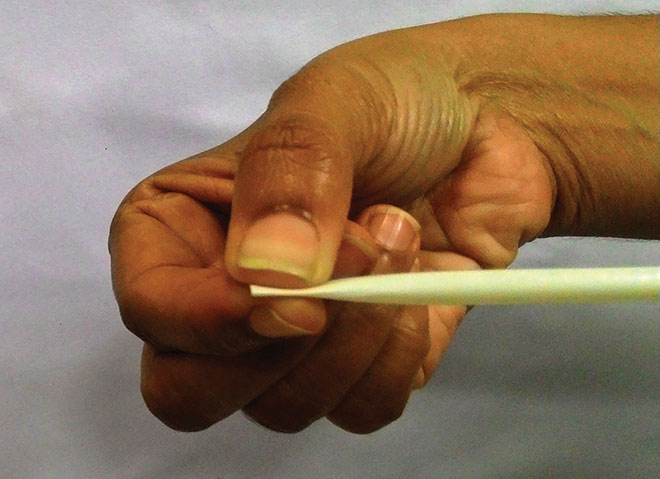
2. Cut diagonally across the flattened end from both sides so that it looks like a pencil point. This is the reed end.
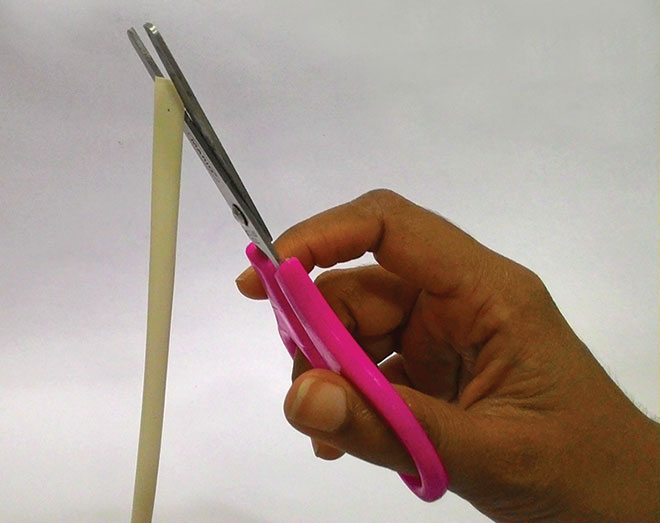
3. Put the reed end into your mouth and blow into it.
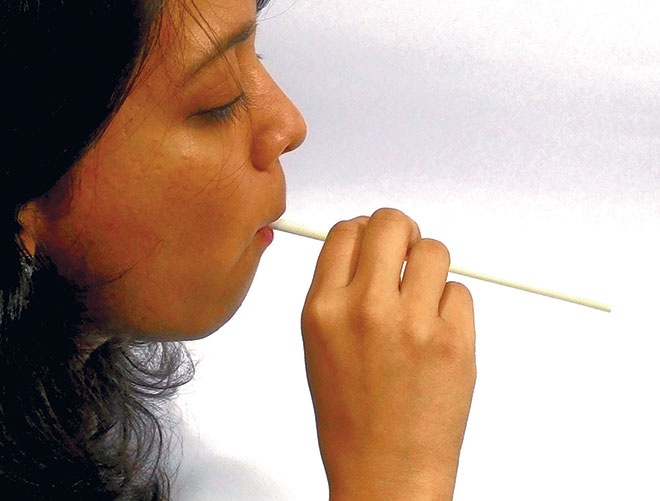
See:When you blow through the straw, it makes a sound like a musical instrument.
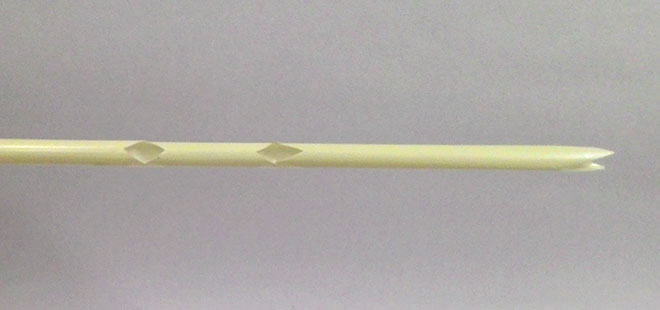
Cut two or three holes along the length of the straw as shown. Now, you can manipulate the sound by blocking or unblocking the holes in different combinations.
Think about:
How did music come out of the straw?
Sound waves are created by the vibration of an object. When you blow on the reed end of the straw, the two pieces of the tip vibrate. The vibration travels back and forth along the length of the straw, creating a wave in the air inside the straw. This wave travels through the air till it reaches your ear where it is received as sound. It’s the same science behind speech. When we speak, our vocal cords vibrate, thus creating sound.
Let’s find out:
How does a flute produce sound?
When air is blown into a flute, the air vibrates along the length of the flute which creates the sound. The length of the flute determines the sound, as the time taken for the vibrations to travel long the flute also changes (you can try it with the straw by cutting at various lengths). When you open or close the holes on a flute, it changes the frequency of the vibration, as the air waves escape through the holes instead of exiting through the other end. This helps a musician produce different notes in a flute.
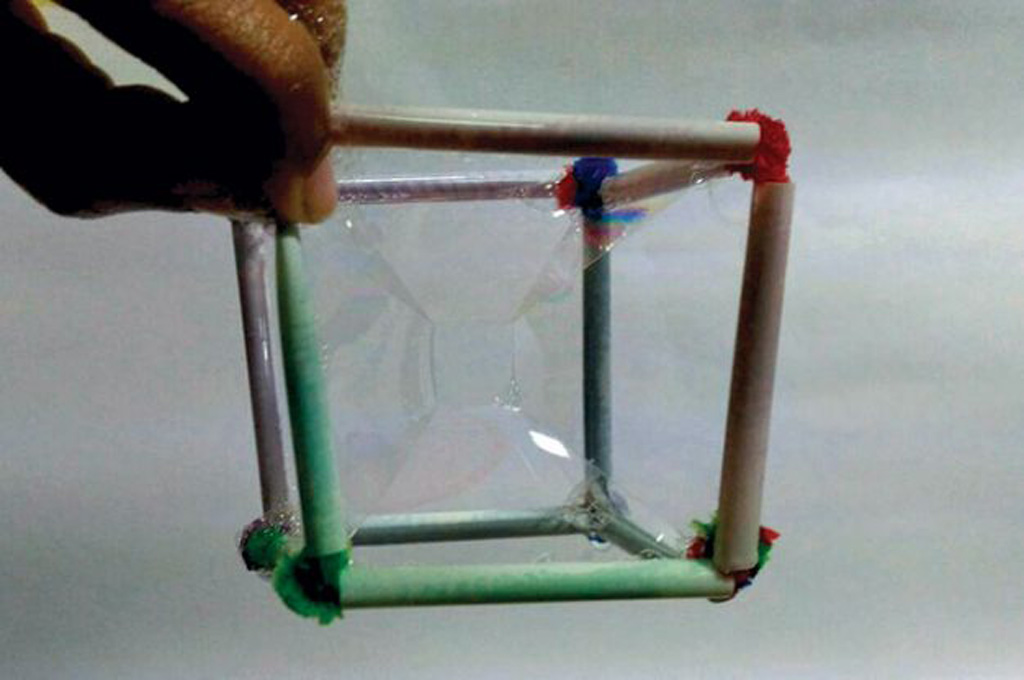
Stuff:
• 4-5 Straws (depending on size of the cube),
• 8-10 pipe cleaners/ chenille sticks (depending on size of the cube),
• Liquid dish soap Glycerine, Scissors ,
• A large bowl of water (big enough to immerse the cube)
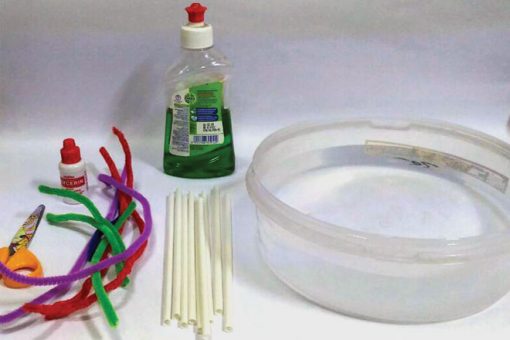
Do:
1. Take a bowl of water and add 2 tablespoons of liquid dish soap to make a bubble solution. Stir gently. Add 1 tablespoon of glycerine to make bubbles last longer.
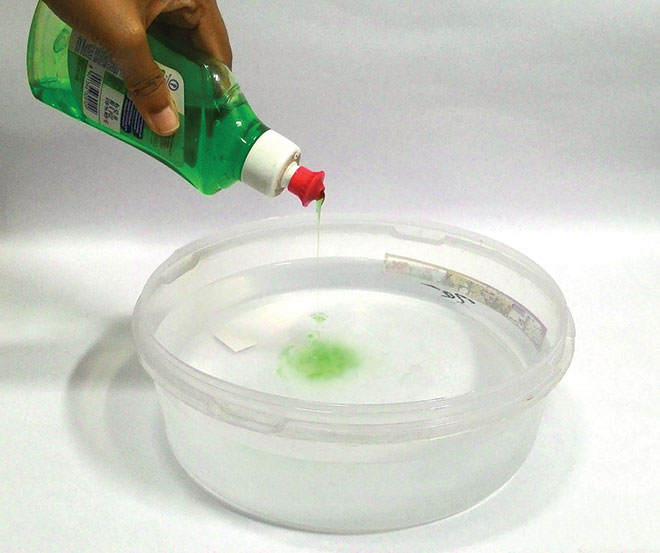
2. Cut a pipe cleaner about 5 inches in length and bend it in half.
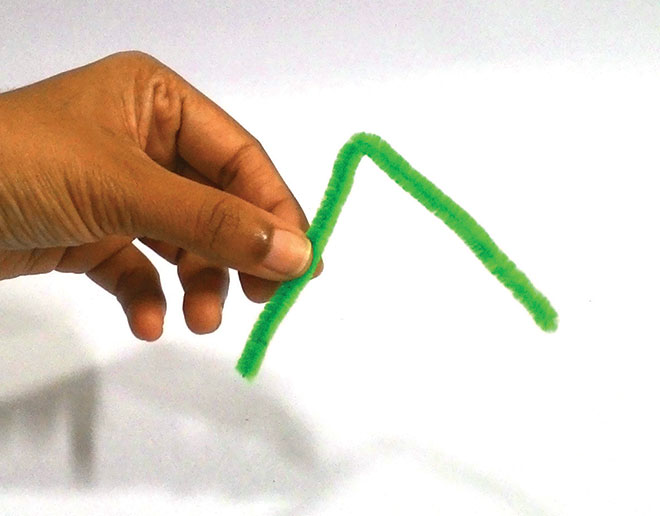
3. Take a third piece of pipe cleaner about 3 inches in length and fix it to the bent piece to form a pyramid shape as shown. Make three more such pieces.
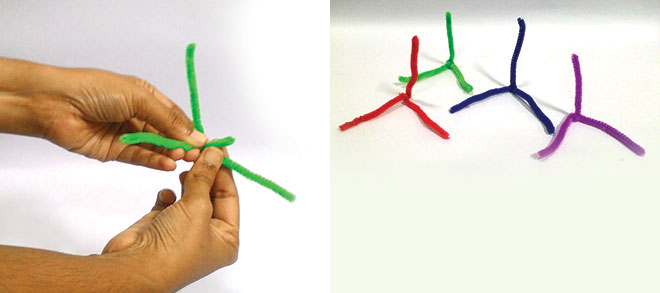
4. Take a piece of straw and cut it into small pieces. Each piece should be smaller than the length of the pyramid’s legs. You will need 12 such pieces of straw.
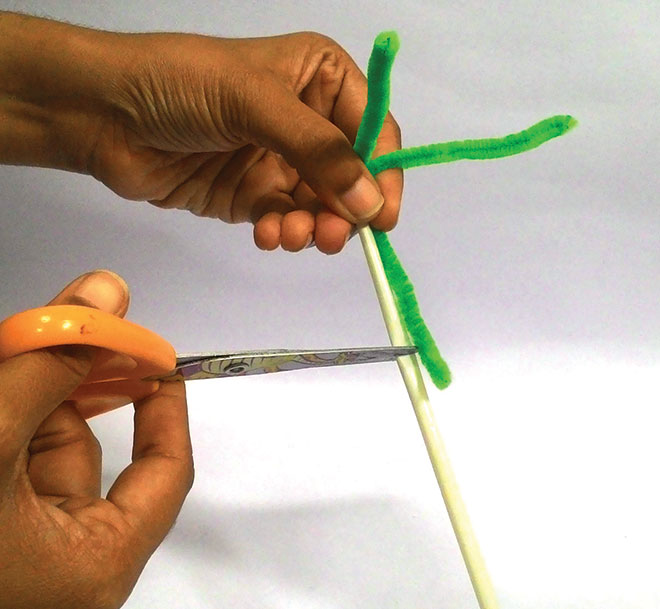
5. Put the straws around the pipe cleaners in all the 4 pyramids. The legs of the pyramid should extend beyond the straw.
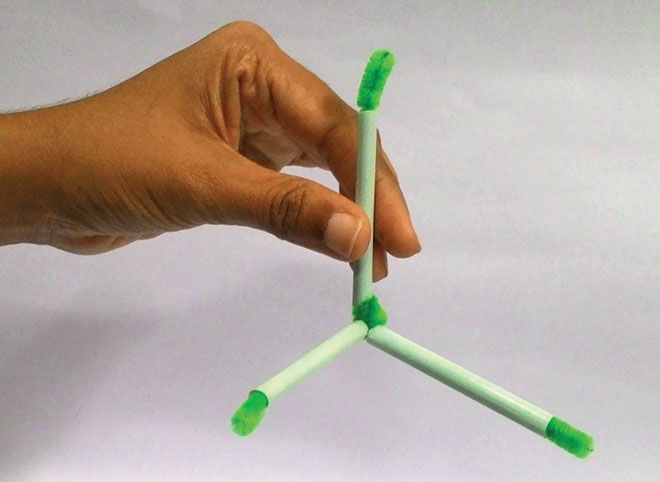
6. Join two of the pyramid-shaped pieces as shown by twisting their ends together to form a table-like structure. Join the remaining two pieces to it. You now have a cube.
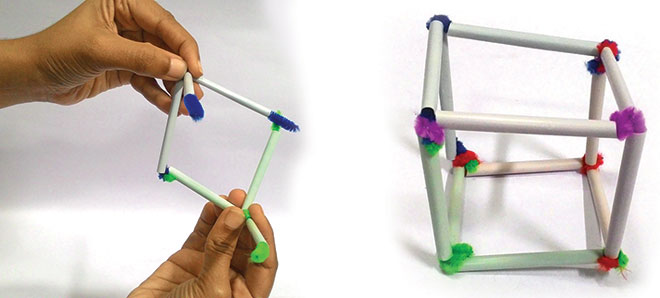
7. Immerse the cube into the bubble solution. When you take it out, you will see flat bubble surfaces have formed on the sides of the cube.
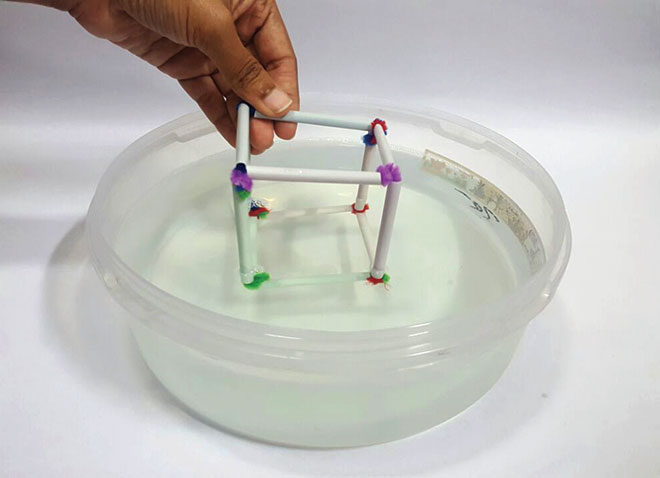
8. Now take a straw, dip it into the bubble solution and gently blow a bubble into the centre of the cube.
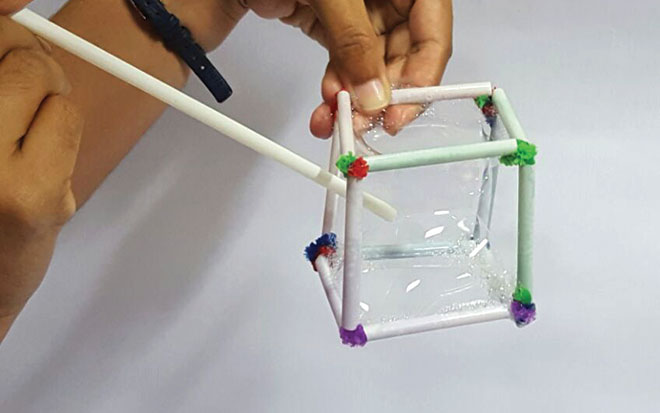
See: You will see that a cube-shaped bubble starts forming in the centre. You can increase its size by blowing more air into it.
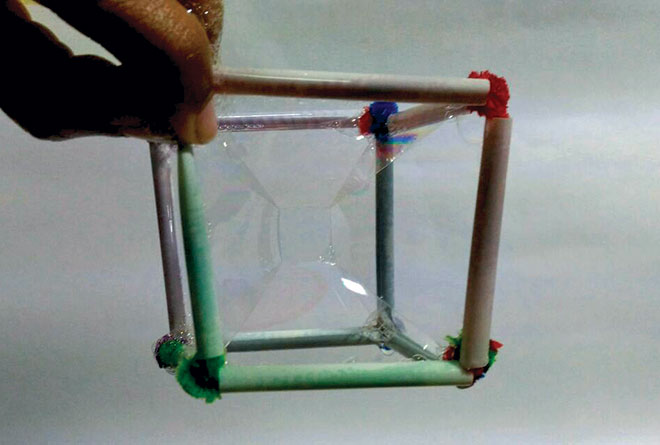
Think about:
How is the cube-shaped bubble formed?
Bubbles are usually round. A sphere has the smallest surface area, so the walls of the bubbles are thick. Hence, it is the most stable shape for them to be in. When a bubble is surrounded by other bubbles like the flat bubble surfaces of the cube in this case, it sticks to them and forms other stable shapes with corners and sides. Thus, the smaller cube bubble is formed inside.
Let’s find out:
In this experiment, we create bubbles for fun, but blowing bubbles in different shapes is important for the glass industry. Similar to how the shape of a bubble can be changed by blowing into it, glass when molten acts like a bubble. When solid glass is subjected to heat, it becomes molten and flexible. Then glass objects of different shapes can be made by blowing air into this molten glass and shaping it using other surfaces. After it is shaped, the molten glass is cooled to make it hard again.
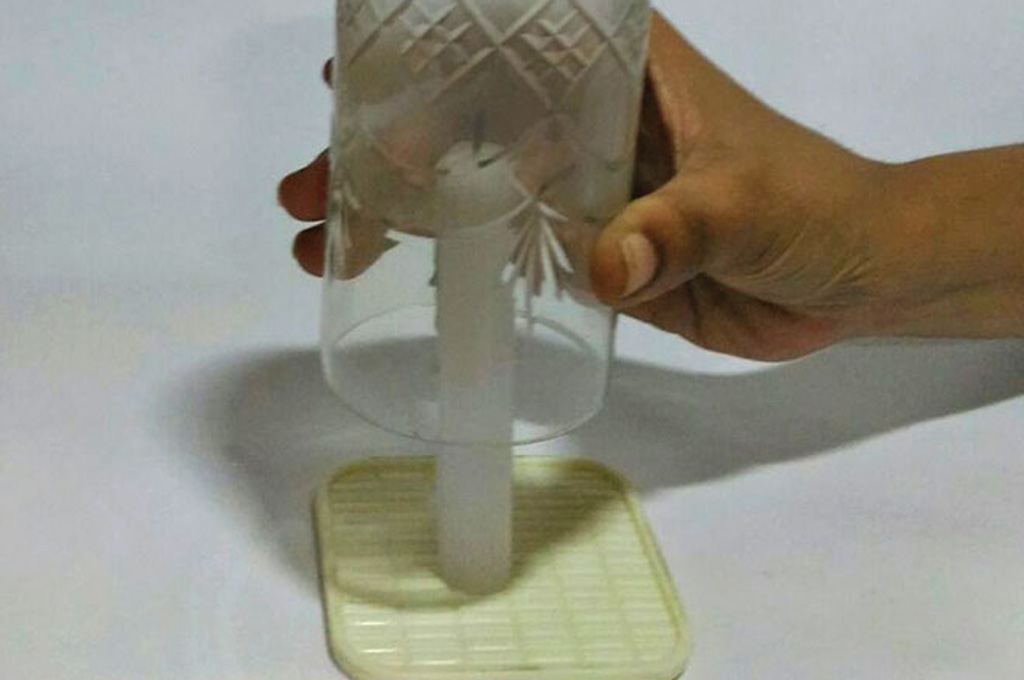
Stuff:
• Cylindrical bottle,
• Drinking glass,
• Candle,
• Match box
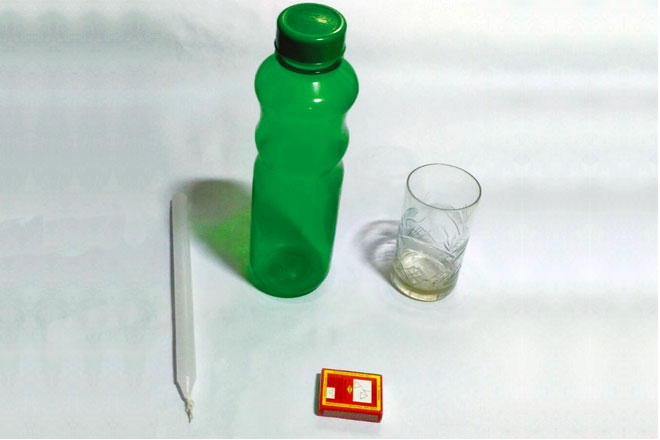
Do (I):
1. Place the bottle before a lit candle.
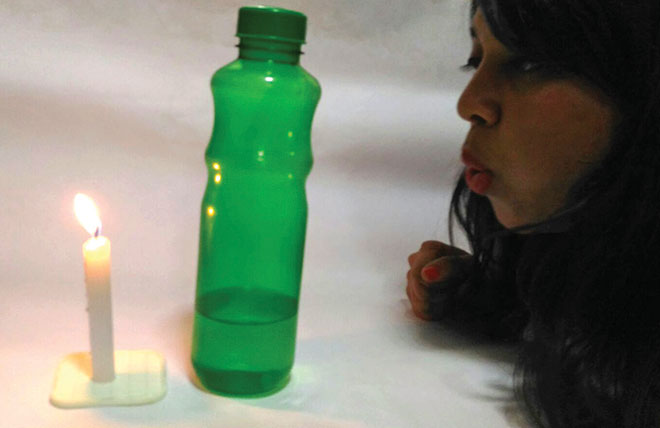
2. Stand behind the bottle and try to blow out the candle.
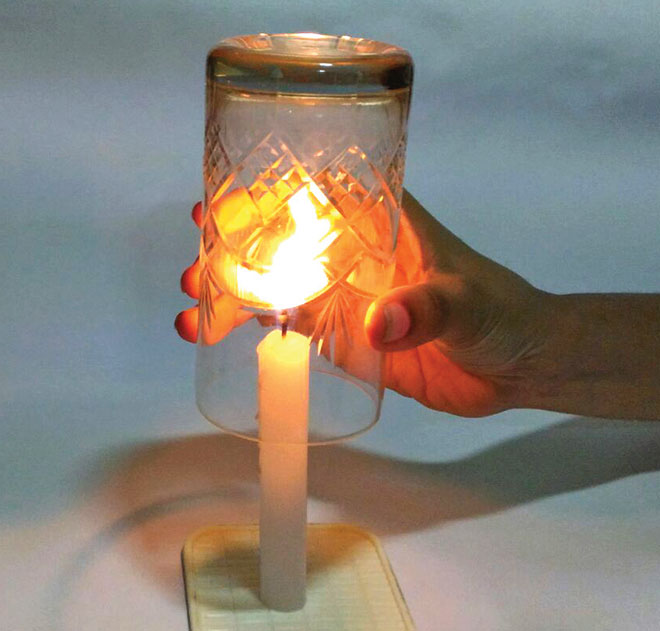
See: Despite there being an object between you and the candle, the flame goes out.
Think about:
Why does this happen?
The reason the candle goes out despite having a bottle in front of it is because of aerodynamics. When you blow at a rounded or cylindrical surface, the air will tend to stick to the surface even as the surface curves, this is called the Coanda effect. This way the air curves all the way around the bottle, and can blow out the candle.
Do (II):
1. Cover the lit candle fully with the glass and watch the flame go out.
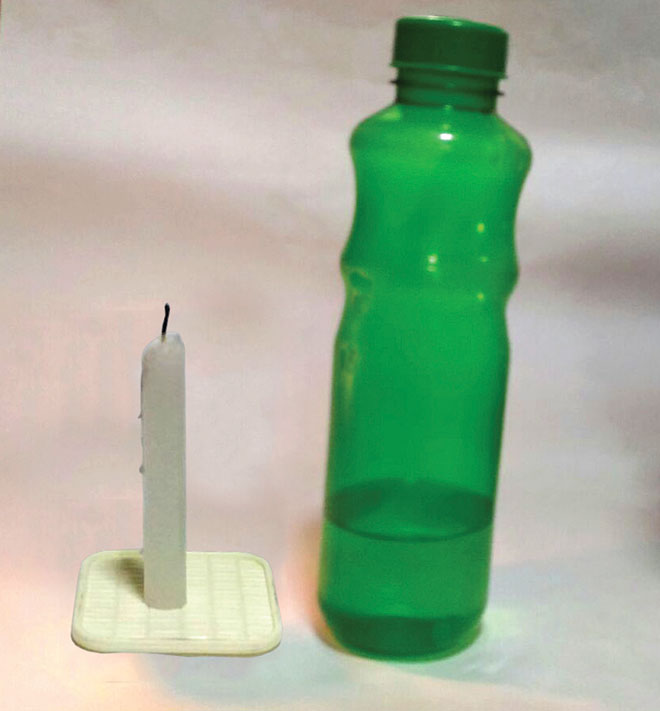
2. Now, try it again without setting the glass down fully as shown.
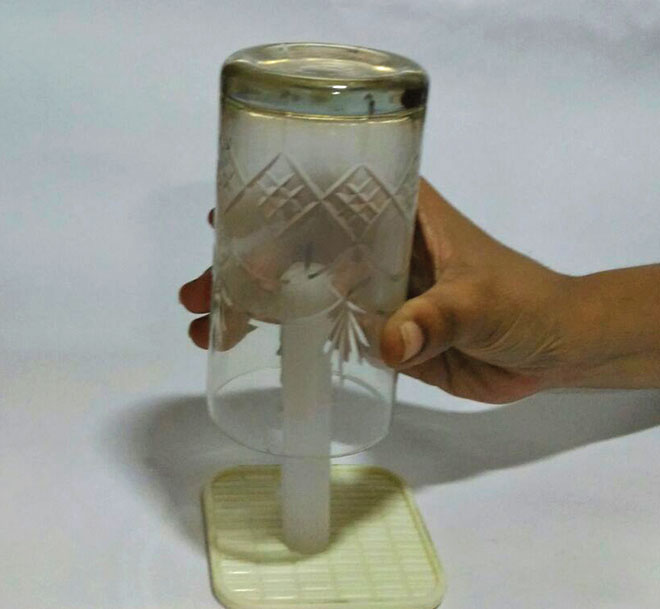
See: Despite the air supply not being cut off, the flame goes out.
Think about:
Why does this happen?
The flame requires oxygen to burn. The burning candle uses up the oxygen and heats up the air inside the glass. This hot air, which does not have much oxygen left in it, rises to the top of the glass and stays there, instead of circulating. This prevents the fresh air outside the glass from flowing in to supply the flame with oxygen. Thus, the flame eventually goes out due to the lack of oxygen.
Let’s find out:
Why does blowing on a flame put out a candle?
When we light a candle, the flame melts the wax near the wick. This liquid wax is then drawn up the wick and gets heated by the flame until it turns into gas. This gas mixes with oxygen in the air and keeps the flame burning. The heat in turn melts more wax and thus the cycle continues. When we blow on a candle, we reduce the temperature at the wick to a point where the liquid wax cannot turn into gas, and is unable to sustain the flame. Thus, the flame goes out.